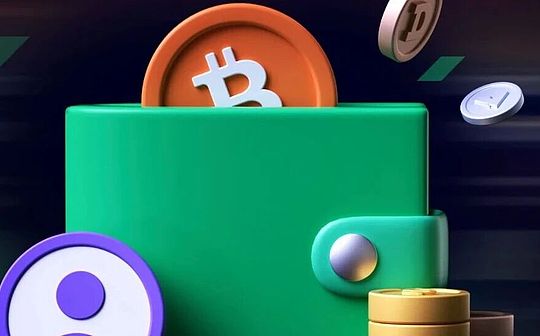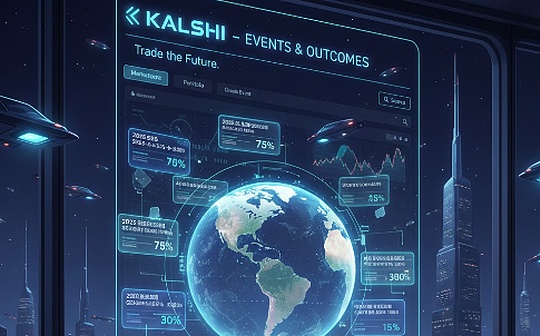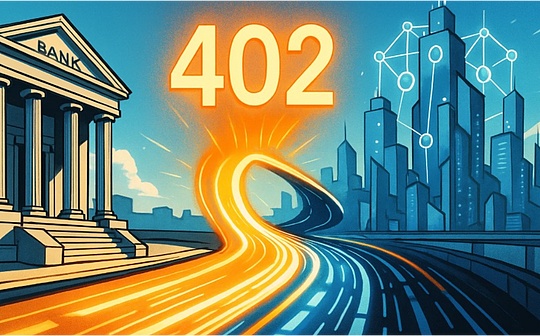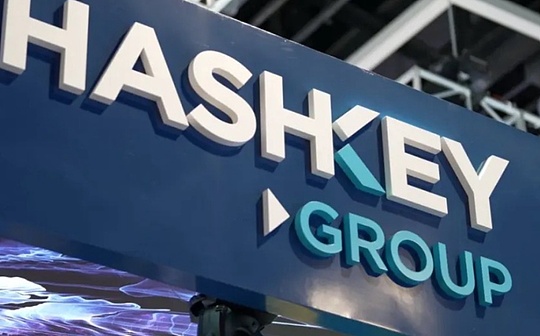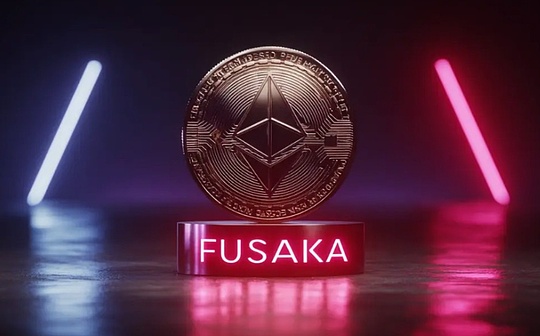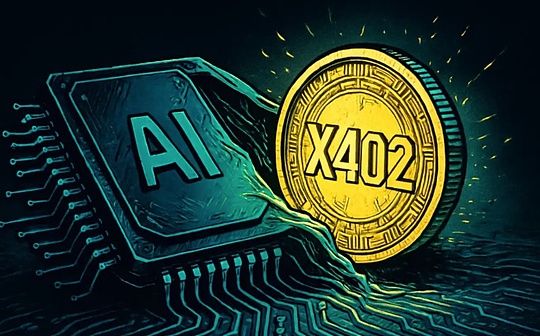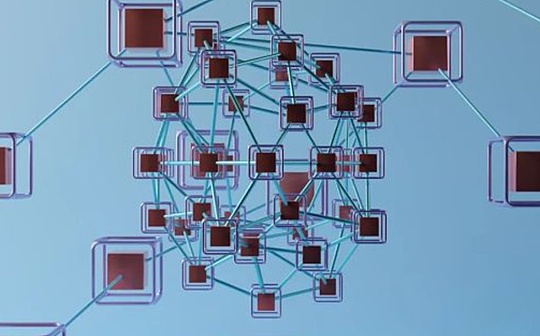
Author: Joey Shin, iosg Ventures
Let’s imagine that every financial behavior is not just a world of simple trading.
This is a complex world composed of information, value and timing, all of which are guided by the “invisible hand” of the blockchain prophecy machine.In the dynamic Defi world, there are things that are particularly noteworthy, called prediction machines to extract value (OEV).This is a special value, because the price of the blockchain prediction machine updates the price -or sometimes the price does not update the price -and can be captured.This article will take you to OEV, exploring its source, its working principles, and how people are smarter from the small gap between the real world and its underlying chain/protocol update value.
But OEV’s narrative is not only that, we should also pay attention to an innovative platform like UMA OVAL.They are studying how to benefit everyone in Defi (rather than a few people) in DEFI.By exploring the complexity of OEV and emerging solutions like UMA OVAL, I summarized some thoughts and feelings of the OEV field to present it.
Tl; DR
-
OEV definition: When there is a gap between the asset prices in the real world and the (lagging) update on the blockchain, OEV will appear, providing a profit opportunity for the Searcher that uses such prophecy machines to update.
-
UMA OVAL Overview: UMA’s OVAL uses a novel method to manage OEV. By using the packaging chainLink prophecy to update, Searcher will make price feeds.It was then sent to MEV-SHARE to promote a private order auction process and finally returned the value to the agreement.
-
The key issues facing OVAL: OVAL is based on a complex and subtle incentive balance between different entities involved in typical MEV categories.However, OVAL will need to test and improve some factors through field tests, including potential price latency, specific trust assumptions related to centralization, and other low -level parameter settings.
-
Solving the theory of OEV: My analysis shows that although the existence of OEV has a problem, an innovative solution like UMA OVAL can alleviate its negative effects and provide a blueprint for a more fair and sustainable future Defi.
-
For the future personal opinion of DEFI: I advocate the mechanism of developing and implementing the solutions of the agreement layer and infrastructure layer to promote a healthier ecosystem and a more reasonable MEV game theory model.
OEV Introduction Guide
What exactly is OEV?
The prediction machine can extract value (OEV) refers to the maximum extraction value generated by the prediction machine price update or lack of update.The prophecy machine can provide external data such as asset prices for the blockchain contract.However, such updates are discrete, not continuous.In turn, it created information asymmetry and MEV opportunities, also known as OEV.This allows Search Bots to use the temporary differences between various places to achieve profits by using the chain price and real -world spot prices between the price of the chain and the real world spot price.
It should be noted that this can be summarized by the operation of the prophecy machine.For example, if a large transaction occurred on a DEX like Uniswap and a significant change in the price, there may also be “internal prediction machine updates”.
Common OEV strategies, such as FRONT-RUNNING, SEARCHERS monitoring transactions to be processed and inserting higher costs before reservation transactions, using the delayed price differences to profit;Cross -asset transactions before update, then sell to obtain guarantee profits; the most common type is liquidation. Searches can identify the positions of non -debt debts based on price changes, and then quickly liquidate them to receive bonuses.
OEV represents the profit that is captured by temporary differences caused by the discreteness caused by the price of the prophet machine.Search Bots can extract value without contributing value to the agreement.This value belongs to the Searchers that realizes profit, Builders, which is motivated to incorporate large transactions into the block, and then validators that subsequently propose blocks.However, this is based on the cost of agreement users due to large liquidation fines and loss of arbitrage opportunities.
OEV’s negative effects, and why should we pay attention?
OEV will have a negative impact on DAPP and cause damage to end users.Excessive use of robots to use the prediction machine arbitrage and liquidation to increase the total transaction cost, because these robots are unanimously bidded higher than legal transactions to get the opportunity to be included in the block.This directly increases the GAS Fee of the actual user.
In addition, external arbitrage transactions triggered by temporary prediction machine price differences have reduced the profits of liquidity providers in these DEFI ecosystems.Even if the current spot price may provide a significant difference, they can only be forced to accept low profits.Over time, the continuous transaction loss of assets has caused permanent losses to increase the permanent loss of liquidity pool/liquidity provider.Users who try to exchange assets also need to deal with degenerate user experience, such as delaying the execution of transactions, large increased sliding points, and greater losses in forced liquidation.
Several common examples briefly illustrate how OEV activities bring these problems:
-
Clearance: MEV Robotics actively monitor the decentralized lending platform, and uses price prophecy to quickly clear any loan positions with non -debt, to capture bonuses from this activity.This depends on the liquidation loan before the renewal of the prediction machine update the data that is exposed to the inconsistent liquidation transaction.
-
Arbitrage: Robotics are constantly traded on the price of lagging prophecy on a Defi platform, and then immediately sold the assets obtained on the platform that may have already reflected the current spot pricing.This repeated arbitrage extracts value without providing meaningful transactions or liquidity to affected applications.
-
Running: In order to maximize the profits obtained from predictable prophecy incidents, the MEV robot inserts high transaction fees orders and regularly before the expected user transaction triggers.By confirming their extraction transactions in the short delay window before the main pricing update, the robot can use the differences before the actual user’s competition transaction.
However, what is even more disturbed is that the robot has extracted the value without any mutually beneficial interaction or support for the underlying DEFI protocol support.They use temporary prediction aircraft inaccurate, and they are actually not trading or providing liquidity in these platforms, and further inspire the leading Builder ecosystem.The tips paid by robotics only arranged their transactions in order to give priority to their transactions, which exacerbated block space competition and contributed to centralized infrastructure, rather than benefiting end users or applications.
Overall, a large amount of value has accumulated to the prediction machine data hunter and the main blockchain verification person, rather than the return to the growth or sustainability of nourishing the ecosystem.The exit of the income lifeline to the external actors who seek unilateral profits have seriously affected the growth of decentralized finance.The capture of the prophecy machine to extract value is transferred to an application that generates value, and the core economic sustainability of DEFI provides a path.
What is order stream auction?
The order stream auction (OFAS) aggregates SWAP intent and transactions, and sorts them according to fair sorting standards.This model aims to minimize the negative effect of the MEV strategy.
OFAS allows traders to easily release the Swap intention they want, and then fill in the exterior of each other.This provides traders with the optimal prices across various decentralized and centralized liquidity places, without having to manually find the best rate.
In the OFA structure, Swappers only needs to release their transaction intent, and specialists are optimized through various liquidity sources and actively execute transactions.These liquidity sources include automatic as municipal business and private liquidity pools, which can use these sources to meet the exchange needs.
Plumbers are actively competing to provide the most favorable trading rate for initial SWAPPERS.The difference between their profits comes from the exchanges between the actual execution price and the exchange rate provided to the publisher.
The main benefits of using OFA for transactions include: to reduce the negative external nature of MEV by trying to sort in fair transactions, provide better prices and overall efficiency for initial traders, simplify the decentralized transactions of cross -current radical sources, and batch transactions to improve execution efficiencyEssence
By outsourcing the order for competitive orders, the OFA structure simplifies the process of SWAP in a complex mobile personality, and at the same time provides traders with consistent favorable pricing.
Solving the OEV protocol example
API3
API3 has a breakthrough significance by implementing an OEV-SHARE’s OFA mechanism called OEV-SHARE, which is specific to OEV.It allows SEARCHER to bid for the exclusive right to execute the API3 data source update. These data sources come from the first -party prophecy machine under the chain. The API provider owns and operates, and captures the OEV profits related to these transactions.The meta transaction signed by the API3 prophecy machine enables the winning bid to update the data source.
API3 introduces the method of competitive OEV auction to the existing prophet infrastructure, which brings several key benefits
-
The auction has maximized the efficiency of value extraction by linked the prediction machine event and incentives.
-
Secondly, by returning the income to the affected DAPP instead of external accumulation, the model prevents the value from leaking from the network
-
Third, the competitive pressure in the auctions naturally reduces the cost and increases the timeliness of the update.This allows API3 to provide a large -scale cheap, accurate, and low -delayed data source -this DEFI is further adopted.
-
Take a step back, the OEV architecture of API3 creates a sustainable closed -loop model with mutually beneficial parties: Search Bots to obtain OEV profits.DAPP receives a new source of income and pays a lower rate for key prediction machine services.API3 itself benefits from a profit model for the development and operation of the infrastructure development and operation of a sustainable funding.
This is currently “balanced” (it is not fully balanced because it introduces negative externality, but the interaction of different entities in the MEV architecture is to some extent) How to achieve it under the MEV incentive mechanism?
Searcher obtained a organizational path and captured the opportunity to be ignored, these opportunities exceeded MEV at the transaction level.Although a structured bid process may introduce minor procedural friction, the improvement of efficiency and reduction of competition will ultimately increase income.Since the update will be specified to a specific search person, it will be compatible with any block generation and verification solution -for example, it does not require private MEMPOOL.Then the auction income will be distributed back to the agreement, which means that they will realize the income that may have been leaked.
>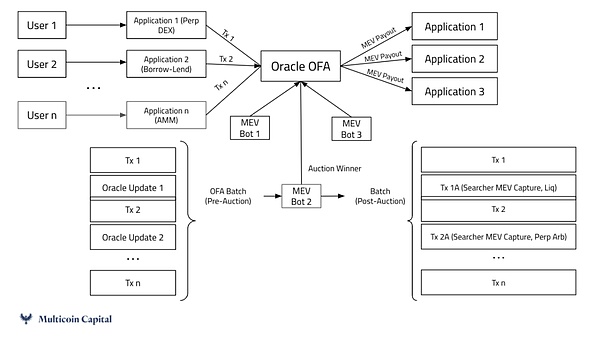
Source: Multicoin Capital
Pyth Network is pioneering a new method of solving OEV. This method is based on its leadership in providing the existing market market market.Pyth recognizes that the proprietary data obtained from the actor, liquidity providers, exchanges, and other direct ecosystem participants is better than the accuracy and latestness than third -party aggregation pricing.
By accessing these high -quality data streams, Pyth’s prediction machine design provides a significant higher fidelity authenticity and lower delay pricing information for contracts that require real world value.Pyth also implements a demand pull model that allows contracts to accurately obtain price updates on demand, rather than relying on intermittent push -provided.This increases flexibility and reduces network expenses.
At the intersection of the key blockchain price data and contract execution logic, Pyth looks very suitable for mediation’s valuable space provided by price information.By aggregating the opportunity of embedded applications for the information flow of the prophecy machine, Pyth intends to promote global order flow auctions and distribute transactions to specialized robots.Different from strict value of external accumulation, Pyth can return contract interaction profits to DAPPS that uses it.
For Pyth’s neutral prophet network, the benefits include new revenue sources without affecting the independent status of the ecosystem.Through large -scale integrated information flow access between networks, a specific auction of fragmented applications can be avoided.The more competitive pricing in the OEV incident capture value.
The interaction in the MEV ecosystem allows the protocol to have a better mechanical balance than the current OEV life cycle process.The core uniqueness of the Pyth network is that through the establishment of a proper data sharing incentive between the first party and the contract platform, it clearly recognizes the role of the prophecy machine.By obtaining the price of the chain directly from the market participants, Pyth enhances reliability through minimum delay, and at the same time, the ecosystem incentives are aligned between the application of consumer data and the platform of production data.Searcher achieves efficiency by organizing valuable instances in block space connected to the prediction machine.Builder exchanged unlimited profitability to monitor the reputation of key market events.The key is that the advantage of Pyth promotes the reorganization of the profit to the integrated application through the aggregate data stream auction, and nourishes the ecosystem through the recycling income growth rather than waste.
UMA OVAL
>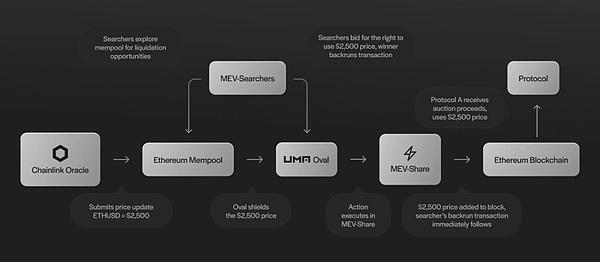
Source: https: //medium.com/uma-project/announdcing-Oarn-PROTOCOL-RAPTING-Oracle-MEV-877192C51Fe2
Working principle
UMA Oval and Chainlink’s existing price-feeding infrastructure integration, and use Flashbots’ MEV-Share architecture to promote orders for orders renewed around prophecy machines.
When the price of ChainLink was submitted to the blockchain, OVAL essentially packed the access of the latest data.This allows Search Bots to bid and compete and unlock the right to unlock and “pre -operation” the right to use the opportunity of OEV.
The trusted intermediary node, known as the OVAL node, is responsible for verifying the bid of Search and configuring the value distribution rules.They submit a unlocking transaction to release the update and related pre-operation bid as a bundle package and submit it through MEV-Share.
MEV-SHARE runs a standardized private order stream auction, coordinating the broader Builder and Validator network.The bidder of the auction included their binding pre -operation transactions together with the price information flow unlocking, in order to use arbitrage or liquidation events.
Then, according to the refund rules set by OVAL nodes, some profits were re -integrated to integrate OVAL borrowing platforms and other protocols, and also distributed normal amounts to Builder and Validator (this is the improvement of the improvement bonus rate of liquidation inherent in the OVAL mechanism.of).In this way, value returns to applications, rather than allows all profits to accumulate to Search Bots and external validators.
It should be noted that no one is affected in the current MEV process except the Builder and the protocol itself.Searcher uses existing technologies, which seamlessly integrated, and the cost is re -assigned back to the BUILDER’s profit -it is controlled by metadata by bundling transactions.Validator is still paid because of the proposed block, which is also a profit from Builder, which may add some delays contained in blocks during the congestion period (this will be further discussed in the report).However, Builder can have a stable private order flow through MEV-SHARE, which inspires them to produce blocks, especially when MEV is high, which will cause higher costs to be assigned to Builder to include in.It also suppresses bad behaviors, because MEV-SHARE can include bad actors from the agreement on the agreement.
In short, OVAL uses the existing prophecy machine and MEV architecture to access valuable data information flow updates.By controlling the release time, you can conduct search auctions and return part of the generated profit to the affected applications.
OVAL’s trust assumptions
There are three core components in the OVAL mechanism -the agreement of the integrated system, the OVAL node to control the auction, and the Builder/miner participating in the transaction sorting and confirmation.This introduces potential trust issues:
The agreement rely on the OVAL node to set the accurate refund rule to return the value, and the release price is updated without delay or reviewing price.However, this will not damage the operation of most of the protocols using the Chainlink, but in the worst case, the protocol may lose the income belonging to Builder and lead to a delay in price update.
OVAL relies on MEV-Share/Builders to not leak the latest value of update, does not change the preferences of Search, and sends the correct pre-operation valid load.However, in the worst case, this will not damage the core operation of the protocol, but the agreement may lose the income that originally belongs to Builder and may lead to delay in price update.
Both OVAL and MEV-SHARE trust BUILDERS to abide by the submitting the packaging rules in the Bundles, and do not separate transactions to steal profits.OVAL chooses Builders that users can choose.From the perspective of Builders, the incentives of profit -making from OEV are less incentives from being prohibited from receiving such private auctions.Flashbots By thoroughly exploring and testing this balance mechanism, the incentive mechanism prevented the BUILDERS of bad behavior stealing MEV profits:
(Github: https: //github.com/flashbots/dowg/blob/main/fair-market-principles.md)
The worst case here is that specific liquidation is like today -a Builders stealing OEV is equivalent to a BUILDERS to capture the MEV they made today.
Although reputation and financial incentives are usually enforced well, the dependence on intermediaries has created risks.If the OVAL node fails to release an update or redirect, the income capture will stop, but the core pricing function will continue through the underlying information flow of ChainLink.
In short, OVAL uses the existing prophecy machine and MEV architecture to access valuable data information flow updates.By controlling the release time, you can conduct search auctions and return part of the generated profit to the affected applications.
Possible risk points and refutation
One key question is why UMA chooses to adopt an intermediary auction model through OVAL instead of directly implementing the Dutch auction method on the liquidation event in the lending agreement.Compared with automated clearing incentives, Dutch auctions may generate low and slow income for the platform.For high -risk scenarios such as loans, maximum speed and reliability are critical.OVA L uses the existing MEV architecture to help ensure liquidity in these cases.
Another concern is whether the user may try to review the price update and release by bribing Validator without proposed unlocking some blocks that unlocks new data.However, this attack may maintain a high price on multiple blocks.Users must largely bid more than the existing tips that BUILDER and Validator have received to prioritize their trading packages.Unless it is extreme situation, the incentive of maximized income still supports containing instead of review.
Another risk problem is that what can prevent the well -constructed proprietary MEV capture system that can construct an alternative around its own Feeds instead of integrating with intermediary solutions like OVAL.One relief is that the recovery of MEV income to the prophet provider can be used as a useful capital mechanism for the continuous development of Chainlink.OVAL provides verification paths to achieve this goal through agreement -level integration.
In addition, trust assumes that most of them are alleviated by the delay of possible small prices -as mentioned earlier, the most likely analysis is up to 3 blocks.In the normal operation of the lending agreement, the price delay of up to 3 blocks is expected to not have any measured effects.This is very different from how price delay affects market transactions or rapidly developing products.When liquidation is required, the included rate of the next block (no delay) is 90%, and the inclusion rate of the two blocks is 99%.UMA’s experts do not think that this delay will cause a large price to move enough to consume the existing clearing buffer.
In the end, a potential vulnerability is whether the Builder responsible for orders and transactions may be possible to steal OEV profits through BackRun instead of respecting the auction mechanism.However, inspiration alignment still supports an OVAL system to obtain private order flow from Flashbots.The risk of reputation and the risk of being cut off by the entire ecosystem provides strong protective measures for individual theft, and potential disposable income is compared to the dwarfed from the continuous income flow obtained by the rules.
Our ideas for OEV
OEV-overall thinking
Although there are many solutions to OEV (especially in order to reintegrate value into the protocol/ecosystem), users are still negatively affected to a certain extent.Solutions such as BroadCaster extract value (BEV) are trying to alleviate the pressure of the MEV’s opposite side, which may be an interesting direction considering in other OFA model protocol design.In order to further alleviate some trust assumptions brought by the OFA model, we are glad to see that the new OFA mechanism can also be implemented at the agreement level.
For example, the OEV is summarized to even changes in the internal price (such as the introduction of the instructions) allowed protocols to further reduce negative external effects.Taking OVAL as an example, as Wrappers can access external data prediction machine events to re -assign value, the agreement can regard these influential transactions as internal data updates.
For example, Uniswap can set a threshold, and any transaction exchange greater than $ X must be routed through an OVAL -like packaging system.This will allow Uniswap to auction to access the right, allowing robots to BackRun or arbitrage specific large transactions.
Then, as OVAL returns the value from the liquidation to the loan platform, this UNISWAP realization can return some profits that can affect the impact of huge transactions to the UNISWAP protocol, liquidity pool, liquidity provider, and even protocol users.
View of UMA OVAL
Although UMA OVAL cleverly uses the existing architecture to capture and redirect OEV, the system depends on the fragile incentive Alignment and trusted intermediaries to introduce security risks.
OVAL nodes and order flow mechanisms are optimized, but they open the attack vector.The collapse in the worst case of intermediary trust or incentive model may still have a delay in key data flow and make more value -related value extraction.
However, this method does alleviate some negative external effects in the current paradigm.As a temporary solution that improves sustainability, OVAL may bring meaningful income to affected applications.Nevertheless, concerns about the increased centralization, transparency, and delay still exist. If it is not thoroughly tested, these may become future attack vectors.
In general, UMA OVAL represents an innovative attempt to recover the value leak, but it may not fundamentally solve all core incentives that make all opportunities as possible.Just like any novel encrypted economic system, these mechanisms need to be widely reviewed, audited, and real -world tests under different operating conditions before evaluating the real robustness and resistance of mining.
I was very excited to see that OVAL transformed discussions and stimulated continuous research, because they solved some outstanding problems that have not been directly solved in the OEV field.But with the development of consideration, comprehensive understanding of risks and income will be the key.
Related link
API3
https://hackernoon.com/what-drace-edractable-dalue-oev
https://medium.com/api3/defi- oracles-man-broken-3c83144A7756
OEV
https://banklesspublishing.com/undrsestanding-Mev-and-opPortunity- Oracle-Extractable- Value/
Pyth
https://multicoin.capital/2023/12/14/Ooracles-nd- News-frontier- Application-Owerflow-Auctions/
UMA
https://medium.com/uma-project/announdconcing-Oarn-PROTOCOL-Revenue-By-Capturing- Oracle-MEV-877192C51FE2
https://www.theblock.co/post/273925/uma-rolls-Out-OVAL-CAPTURE- ORACLE- Extractable-Value-in-DEFI-PROTOCOLS
I hear the UMA team is really great, so pls tell me I'm wrong 🫣
instead of: UMA uses public @chainlink feeds
from now on
– UMA runs centralized OVAL server
– server wait to see chainlink Tx in mempool
– creates new "look! an update" Tx
– send Tx to FB MEV-share server (running… https://t.co/6neCVuQ1YS— Uri Klarman ⚔️ (@uriklarman) January 24, 2024
Part.2 IOSG post -investment project progress progress
EIGENLAYER completes $ 100 million in financing, A16Z participates in investment
* RESTAKING
IOSG Ventures’ investment portfolio encrypted reconstruction service provider EiGenlayer announced that it has completed $ 100 million in financing and A16Z participated in the investment.Eigenlayer was founded by Sreram Kannan, supporting the tokens to be deposited or “re -mortgaged” to the network to support the verification of transactions on the blockchain, helping the new projects built on Ethereum using the security of the blockchain to ensure their own.network.
DEFILLAMA data shows that Eigenlayer’s total locking value (TVL) currently exceed $ 8 billion.
Coinbase will go online Starknet (Strk)
* Layer2
On February 22 news, Coinbase Assets Twitter stated that Coinbase will add support for StarkNet (Strk) on Ethereum network (ERC-20 toke), and the platform marks the asset as “experimental” label.Do not send this asset through other networks, otherwise the funds may face the risk of loss.If the liquidity conditions are met, the transaction will begin later today.Once the asset supply is sufficient, the Strk-USD transaction will start the transaction in stages.
StarkNet: Cross -chain Bridge Starkgate 2.0 main network is launched
* Infra
According to the news on February 22, Starknet announced on the X platform that the main network of the cross -chain bridge Starkgate 2.0 has been launched. Now it has supported the functions of one -click withdrawal, withdrawal, and rapid withdrawal.Deposit service.
OKX Web3 wallet has fully supported the Starknet ecosystem
* Infra
On February 21, according to official news, OKX Web3 wallets have fully supported the StarkNet ecology.Among them, the wallet sector has supported the addition of the StarkNet network and the asset management on the chain, and passed the GIVEAWAY inspection and received the Strk airdrop. The DEX section has supported the asset exchange on the StarkNet chain and the cross -chain exchange with the 12 mainstream EVM public chain. The discovery sector has been establishedStarkNet Defi Spring Zone helps users explore the popular ecological DAPP at any time and win the reward. More exclusive ecological airdrop activities will be launched soon.In the future, the OKX Web3 wallet will continue to support the development of StarkNet, and optimize product functions, bringing users the best experience of one -stop play to the Starknet ecosystem.
Part.3 Investment Financing Event
>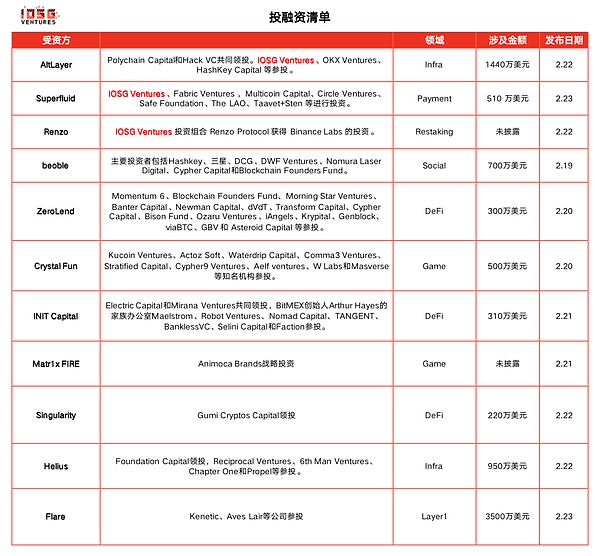
Rollup is the service protocol Altlayer to complete the US $ 14.4 million strategic rotation financing
* Infra
The Rollup is the service protocol Altlayer to complete the US $ 14.4 million strategic rotation financing, and Polychain Capital and Hack VC co -owned.IOSG Ventures, OKX Ventures, Hashkey Capital, etc. participated in the investment, which ended in September 2023.
It is reported that Altlayer is a platform designed to launch native and re -pledged Rollups, supporting Optimistic and ZK Rollup stacks.This project is also the 45th project of Binance Launchpool.
Ethereum fund flow agreement Superflum completes $ 5.1 million strategic rotation financing
* Payment
The Ethereum fund flow agreement Superfluid announced the completion of the $ 5.1 million strategic wheel financing, iosg Ventures, Fabric Ventures, Multicoin Capital, Circle Ventures, Safe Foundation, The Lao, TaAvet+Steen, etc.The SuperFLUID protocol allows encrypted projects such as decentralized autonomous organizations to pay recurring wages and awards in single -chain transactions through its “Super Tokens”, which has completed the $ 9 million seed round financing in 2021.
IOSG Ventures Investment Portrait Renzo Protocol obtained Binance Labs investment
* RESTAKING
IOSG Ventures Investment Portrait Renzo Protocol has received Binance Labs investment.This project is a mobile re -pledged token (LRT) and strategic management infrastructure created around Eigenlayer. It is committed to developing and sharing safety performance on EIGENLAYER and formulating standards for re -pledges.
Renzo Protocol TVL has exceeded $ 370 million.Users can store LST to tokens such as ETH, STETH and WBeth, and receive the corresponding quantity Ezeth.In addition, Renzo is cooperating with the cross -chain agreement to introduce more local ETH on the chain into Eigenlayer through Renzo.
The web3 social agreement BEOBLE has raised $ 7 million in two rounds of financing
* Social
The web3 social agreement has completed the seed wheel financing three months since Pre-Seed announced that the total amount of funds raised has reached 7 million US dollars. The main investors include Hashkey, Samsung, DCG, DWF Ventures, Nomura Laser Digital, CyPher Capital and BlockChain FO. undersFund.The raised funds will be used for the launch of BeOble V2 next month to improve Web3 social media interaction and provide high -level functions such as multi -chain integration, social transactions and OTC functions in application.
According to reports, the web3 social platform BeOble aims to provide enhanced decentralized wallets to wallet communication.With a series of innovative functions, such as earning, attention, discovery, and tailor -made models tailored for the Web3 community, BEOBLE preferentially considers user privacy, security, and contribution.
Institutional privacy DEFI access layer Singularity completes the latest round of 2.2 million US dollars financing
* DEFI
News on February 22, Singularity, which focuses on institutional -level privacy DEFI access layers, was led by the Gumi Cryptos Capital of Silicon Valley and successfully completed its second round of financing.These funds will be used to support the development of agreements in order to promote the compliance access of DEFI and ensure that the commercial secrets of the chain activity.This round of financing highlights top institutions such as Laser Digital, Eureka Partners, and front wheel investors Apollo Crypto, Digital Asset Capital Management, and Gandel Invest.So far, Singularity has raised nearly $ 4 million in funds.
Layer1 Blockchain FLARE completed $ 35 million in private equity financing
* Layer1
News on February 23, according to CoinDesk, Layer1 Blockchain FLARE completed $ 35 million in private equity financing, and companies such as keys and Aves Lair participated in the investment.Early investors in the project voluntarily agreed to distribute tos from 2024 to the first quarter of 2026.In order to reduce the pressure on market selling, the daily transaction volume of 0.5%is also stipulated.
It is reported that FLARE is called the Layer1 network that supports the creation of the smart contract agreement and focuses on the pricing prophecy machine. The prophet passes the asset prices between various decentralized finance (DEFI) applications.
Chain Tour Studio Crystal Fun completes 5 million US dollars of seed round financing
* Game
News on February 20th, Crystal Fun, a decentralized chain tourism ecological platform and studio, announced the completion of the $ 5 million seed round financing.This round of investment is invested by well -known institutions such as Kucoin Ventures, Actoz Soft, WaterDrip Capital, CommA3 Ventures, Stratify Capital, Cypher9 Ventures, Aelf Ventures, W Labs, and Masveres.This fundraising will be mainly used for the development and operation of its games. At present, Crystal Fun has announced four games: “Outr”, “Endless War”, “Starfall” and “Survivor”.In addition, Crystal Fun also announced that it will start the second internal test of the “OUTER” game today, mainly to test the balanced value and pressure load in the game to ensure that players can enjoy the best game experience.
The lending agreement Zerolend completed the $ 3 million seed round financing at a valuation of $ 25 million
* DEFI
On February 20th, the lending agreement Zerolend announced the successful closure of seed wheel financing, raised 3 million US dollars, valued at $ 25 million, Blockchain Founders Fund, Morning Star Ventures, Banter Capital, Newman Capital, DVDT, Transform Capital, CypherCapital, Bison Fund, Ozaru Ventures, IANGELS, Krypital, Genblock, Viabtc, GBV, and Asteroid Capital and so on.
As the largest agreement on ZKSYNC and the third largest agreement on Manta (calculated according to TVL), Zerolend plans to launch its native governance token Zero in the first quarter of 2024.
DEFI project Init Capital completes 3.1 million US dollars of seed wheel financing, Electric Capital and other led investment
* DEFI
On February 21, according to official news, the Mantle Ecological DEFI project Init Capital announced the completion of the $ 3.1 million seed round financing. Electric Capital and Mirana Ventures were co -invested. Tures, Nomad Capital,Tangent, Banklessvc, Selini Capital and Faction participated.PENDLE Lianchuang (@TN_PENLE), Ethena Labs founder Leptokurtic, AEVO Lianchuang Julian, Dragonfly’s Ashwin, Metastreet’s founder David Choi, and CEO TAI Panich of SCB 10X also participated.
This seed round investment will enhance Init’s technical capabilities, market strategies, and the overall status as the main DEFI liquidity layer.INIT also establishes a partnership with DEX and DAPP to create a one -stop store for users to access and manage income strategies.Looping Hook will start on February 28.
It is reported that Init is committed to transforming DEFI liquidity infrastructure through liquidity Hook to provide users and builders with seamless liquidity access and management and asset -available assets.
Modular blockchain developer INCO completes 4.5 million US dollars of seed wheel financing, 1KX led investment
* Infra
According to the news on February 21, according to The Block, INCO, which focuses on confidentially modular blockchain developers, completes 4.5 million US dollars of seed wheel financing, 1KX led, Circle Ventures, GSR, Polygon Ventures, Robot Ventures, Alliance Dao,, and Alliance DaO, andZKSYNC developer Matter Labs and others participated in the investment.
Inco founder Remi Gai said that the company began to make seed round financing in September and closed around November. The structure of this round of financing is a simple future equity (SAFE) agreement plus tokens.Comments on valuation.
It is reported that INCO was established in August last year and today launched the first test network -called Gentry.Its second test network Paillier plans to be released between the second and third quarters of this year, and the main network is scheduled to be released in the fourth quarter.INCO is a modular, interactive Layer1 blockchain network, and is committed to bringing confidentiality to decentralized applications.It can be compared with modular blockchain projects such as Celestia and LAVA. They focus on data availability and data access, while Inco focuses confidentiality.
MATR1X FIRE, MATR1X FIRE, ANIMOCA Brands strategic investment
* Game
On February 21, according to official news, MATR1X Fire, the Yuan universe, announced that it has obtained the strategic investment of Animoca Brands, and the specific amount has not been disclosed.
It is reported that MATR1X Fire is the flagship product of the Web3 Entertainment Platform MATR1X. It is a first -person shooting game suitable for mobile devices. Players can choose from the playable role list and compete in the form of a five -person team to destroy the enemy.
Earlier news, MATR1X announced in February last year that it had completed a $ 10 million Series A financing, and Hashkey Capital participated in the investment. In November last year, MATR1X completed the $ 10 million A-2 round financing, and ABCDE Capital participated in the investment.
Solana infrastructure company Helius completes $ 9.5 million in Series A financing, Foundation Capital led
* Infra
According to the news on February 22, according to Wealth Magazine, Helius, a Solana infrastructure company, announced the completion of $ 9.5 million in Series A financing, led by Foundation Capital, RECIPROCAL VENTURS, 6th Man Ventures, Chapter One, and PROPEL.
It is reported that Helius is a vertical integrated developer platform to help build an encrypted application on Solana.The company was founded by the former software engineer of Coinbase and Amazon Web Services in 2022.The platform provides a set of tools that enable developers to build applications quickly and easily on Solana.In addition, in October 2022, Helius completed a $ 3.1 million seed round financing.
Vitalik: Verkle tree will make a state -free verification device client possible
* Infra
On February 19th, Vitalik Buterin expressed his expectations for Verkle Tree on its x account (vitalik.etH) today.He believes that the Verkle tree will make a state -free verification device client possible, which will allow pledge nodes to almost use hard disk space and be able to simultaneously synchronize immediately, which greatly improves the user experience of separate pledge.This technology is also beneficial to users’ light clients.
He was also excited about the application of AI in the form of code to verify and find loopholes.He believes that the maximum technical risk currently facing Ethereum may be the loopholes in the code, and any technology that can bring major changes in this area will be amazing.
StarkNet -based decentralized permanent derivative L2 application chain Paradex has been launched on the main network
* Layer2
On February 20, according to the official announcement, Layer2 Application Chain Paradex, a decentralized derivative derivative based on Starknet, has officially launched the main network.Paradex is incubated by the cryptocurrency liquidity platform Paradigm (indicated, non -same -name venture capital company).Operating chain.
Vitalik: Precision and complex Layer2 is not the optimal solution, Layer1 should not be excessively simplified
* Infra
On February 22 news, Ethereum Lianchuang Vitalik Buterin just pushed to say that his confidence decreased tripled compared to 5 years ago.After in -depth analysis of risks and balances, Buterin believes that Layer2 is not the most effective solution.He pointed out that if Layer1 failed consensus, although the core developers might need to work all night to repair, the final system can return to normal.In contrast, when Layer2 fails, users may face permanent large amount of capital losses.Based on this consideration, Vitalik proposed to add some complex functions to Layer1 to reduce the pressure of Layer2, thinking that this is a more desirable strategy.
Ethereum Morality Project Ether.Fi will join Manta Network Ecology
* Staking
News on February 22, Ether.Fi, the liquidity pledge project, announced that its product will be launched on the Manta Pacific platform.This means that Manta Pacific users can pledge ETH into the Ether.Fi protocol to get the LSD token EETH and other related rewards.
Earlier, Ether.Fi has allowed users to get ETH pledge rewards, Etherfi points and Eigenlayer points by casting EETH.In February last year, Ether.Fi completed a $ 5.3 million financing.
Web3 map company HiveMapper will launch a new type of driving recorder HiveMapper Bee
* DEPIN
On February 22, according to TechCrunch, the Web3 map company HiveMapper will launch a new type of driving recorder Hivemapper Bee later this year, which aims to use the crowdsourcing community to accelerate the market share from Google.The Bee camera is equipped with a larger GPS antenna and supports 4K 30FPS shooting, which aims to provide more attractive choices for company team customers.It also has more equipment processing capabilities and can upload data from the situation of non -connecting smartphone applications.The pre -sale has begun. The version of the version of the LTE chip is priced at $ 549, and only supports the price of WiFi for $ 449.The delivery of Rapid Rush pre -order will begin in the third quarter of 2024.In addition, HiveMapper encourages the creation of high -quality map data by providing Honey tokens as a reward to the contributors.
L1 Blockchain Injective and DEX Dojoswap launched the “CW-404” standard
* ERC
On February 23rd, according to Coindesk, Layer 1 blockchain Injective launched the CW-404 standard to benefit from the popularity of the ERC-404 standard and transfer to its own network.Injective cooperates with the decentralized exchange DOJOSWAP to provide the CW-404 standard, which is a transplant version of the ERC-404 standard, combining the CW-20 and CW-721 standards.
ERC-404, as an unofficial Ethereum standard, allows multiple wallets to directly have a single non-homogeneous token (NFT), and enables their holders to create a specific use case.Vibration is used for borrowing or pledge holding.
Mind Network introduced FHE technology into its data storage capacity and expansion project, and received ZAMA support
* Infra
On February 22 news, Mind Network announced that it will introduce full -state encryption technology (FHE) into its data storage capacity expansion scheme Mindlake, and has been supported by the leading FHE research company ZAMA.This marks a substantial step forward from the Web3 -end -to -end encryption.Mindlake is a pioneering data storage capacity and expansion technology, which aims to enhance the computing capabilities of encrypted data on decentralized platforms to serve application scenarios such as AI, DEPIN, and Chain Tour.
ZAMA is an open source cryptography company. It is committed to building the most advanced FHE solution to protect the privacy in blockchain and artificial intelligence, and develop advanced encryption tools and solutions for developers.FHE can calculate the encryption data without the need to decrypt.This breakthrough method ensures data privacy and security, and has opened up new possibilities for security data analysis and cloud computing, while does not harm users’ confidentiality.This cooperation with ZAMA has raised the security standards of data calculation on the chain to the new level.
Y Combinator: Stable currency will become an important part of the future of the currency
* Stablecoin
On February 19 news, the latest startup request (RFS) of the well -known American entrepreneur incubator Y Combinator (YC) emphasized that they want to see more people in innovation.These areas include applying machine learning to robotics, using machine learning to simulate the physical world, new defense technology, bringing manufacturing back to the United States, new space companies, climate technology, commercial open source companies, space computing, new corporate resource planning software, Inspired by the existing internal tools, the tools of developer, explained artificial intelligence, large language model (LLMS) used in traditional corporate background manual processes, use artificial intelligence to build corporate software, stable currency finance, way to end cancer, biological creaturesThe basic model of the system, the management service organizational model of medical care, the middlemen in the medical care, the better corporate software “glue”, and the small refined model replaced by the giant universal model.
Regarding the stable currency finance part, YC said that there are many arguments about the practicality of blockchain technology, but the stablecoin will obviously become an important part of the future of the currency.At present, the market has been issued at $ 136 billion in stablecoins, but the opportunity seems to be far from being fully excavated.So far, only about 7 million people have conducted stable currency transactions, and more than 500 million people live in countries with an annual inflation rate of more than 30%.The total amount of customers held by Bank of America is $ 17 trillion, which are potential conversion targets.However, there are very few major issues of stable currency, and the main liquidity providers are even more.Y Combinator hopes to fund the construction of B2B and consumer products, tools and platforms on the top of the stable currency, and excellent teams of more stablecoin protocols.
KELP DAO launches eigenlayer integral tokens KEP
* RESTAKING
On February 21st, Kelp Dao officially issued a post announced that Kelp has launched Kelp to earn points to the point currency KEP, which aims to provide liquidity for Eigenlayer points/rewards.Users can now transfer and trade their KEP and participate in DEFI.All EIGENLAYER points obtained by KELP DAO will be assigned to RSETH holders in a proportion of KEP token in the form of 1: 1.
Curve: The borrowing contract has been deployed, and the user can already borrow
* DEFI
According to the news on February 24th, CURVE issued a statement that borrowing contracts have been deployed, and arbitrage traders can obtain generous benefits. Before the UI officially launch, some liquidity will enter in advance.CURVE said that the borrowing platform has not been officially launched, but users can already borrow through contracts.
As of February 24th, UNISWAP’s front -end transaction costs exceeded $ 8 million
* DEFI
As of February 24, the UNISWAP front -end transaction fee (income) reached $ 8.1 million.According to previous news, the Snapshot vote of Snapshot Proposal to Activate the UNISWAP Agreement will be released on March 1, 2024, and the vote on the chain will begin on March 8, 2024.The proposal recommends an upgrade agreement to make the cost mechanism reward and the UNI token holder who pledged its token to the tokens.The agreement costs are allocated to the UNI token holders who have pledged and entrusted their voting rights according to proportion; 3. Allow the governance to continue to control the core parameters: which pools need to be paid and the cost of the cost.
EIGENPIE: LS
* Staking
According to news on February 25, Eigenpie said that LST has been reopened. Users can deposit ETH LST to obtain EIGENPIE points and earn potential returns from LST.EIGENPIE points holders will receive 60%share of the EGP token IDO, and 10%of the total amount of EGP token supply.
Web3 social media platform Farcaster provides support for Solana address
* Social
According to the news on February 23, according to The Block, Farcaster, Web3 Social Media Platform, has provided support for Solana and combined with the blockchain address to verify the user.It allows FarCaster’s client Warpcast to link users to the solana address of the user compatible with the platform.Farcaster’s founder Dan Romero said this new feature has now been put into use.This Solana integration not only allows users to access, but also introduces Frames, which can directly interact with users who have registered Solana wallets.
ETHGLOBAL announced the 7 projects of hacker loose finalists
* ETH
On February 22 news, Ethglobal announced on the X platform to announce the 7 project list of hackers’ final finalists, including:
1.priv.cast: Anti -counterfeit and private voting applications built with Noir’s FarCaster framework;
2.Veribot: Use ZKML to prove (closed) the source code does not have vulnerabilities in the source code;
3.zkdl: an identity proof project, using zero -knowledge proof to protect user privacy;
4.0XSHADOWS: Sign more wallets, the owner can submit/approve/refuse transactions;
5.zk open banking: a complete private open bank protocol supported by Aztec Network;
6.EVMTRACE: It aims to reveal the use of encryption technology on the chain.Use technologies such as tracking, tracking pre -compilation, pattern recognition, and manual work to collect data;
7. Myriad: A new method of getting actual fun through DAO, allowing users to create and participate in DAO platforms, and can also be introduced into the FarCaster framework.

